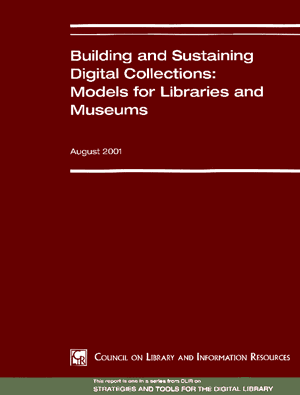
by Abby Smith
August 2001
Copyright 2001 by the Council on Library and Information Resources. No part of this publication may be reproduced or transcribed in any form without permission of the publisher. Requests for reproduction should be submitted to the Director of Communications at the Council on Library and Information Resources.
Presentations of Business Models
- Projects in Scholarly Publishing
- JSTOR
- HighWire Press
- New Enterprises
- International Center for Photography/George Eastman House
- Questia Media, Inc.
- Gateway Services
- Art Museum Network
- Fathom
Recommendations and Next Steps
Introduction
The promise of the Internet to extend the reach of libraries and museums to new users, and to serve traditional users in new and more compelling ways, has pushed many cultural heritage institutions into the new territory of digital programming. Along the way, museums and libraries have discovered that digital distribution is transforming not only the ways in which their collections are used but also the institutions themselves. Among those organizations convinced that digital technology offers new ways of fulfilling their core missions of education, research, and cultural enrichment, the question of what to put online and how to sustain digital collections is hotly debated.
In February 2001, the Council on Library and Information Resources (CLIR) and the National Initiative for a Networked Cultural Heritage (NINCH) convened a meeting to discuss how museums and libraries are building digital collections and what business models are available to sustain them. A group of museum and library senior executives met with business and legal experts, technologists, and funders to discuss the challenges that cultural institutions face when putting collections online and to identify some models for sustainability that support the core missions and do not conflict with the internal cultures of nonprofit entities.
The meeting was supported by the Institute of Museum and Library Services (IMLS), which had also sponsored a meeting that CLIR convened with the Chicago Historical Society in October 1999. At that meeting, reported in Collections, Content, and the Web (CLIR 2000), library and museum experts cited several areas of mutual concern and called for further discussion of them among the two communities. More specifically, they wished to explore how to
- develop sound selection criteria
- identify online audiences and assess user satisfaction
- manage intellectual property rights
- develop and share best practices for a variety of technological issues
- implement cost-recovery strategies consonant with institutional culture
- manage the institutional transformations wrought by new technologies
The 1999 meeting brought together many individuals who had varying degrees of experience with putting collections online. That agenda focused on collections, audience, and technology. By February 2001, a great deal had changed. The dot-com boom had waxed dramatically and was just as dramatically waning. The quality and quantity of institutional experience with the Web had changed significantly. Technology per se had receded as a pressing issue, eclipsed by concerns about copyright, funding, and fundamental questions about the transformation of institutions, staff, and even missions. Participants wanted to learn from those institutions that had gone beyond project-based experimentation to develop self-sustaining enterprises. They also wanted to hear from representatives of Web-based educational and cultural enterprises that had developed models for sustainability. CLIR and NINCH invited several Web enterprises to present their business models to the group. The speakers were asked to focus on issues of the greatest interest to the cultural sector and to identify those elements of their business plans that are suitable for libraries and museums.
This report summarizes the information shared by presenters and the discussions that ensued among participants. On the basis of the day’s discussions, the group was asked to propose an agenda for action; these recommendations appear at the end of the report. Not surprisingly, the discussions kept coming back to two of the central economic and societal questions of this time: Who owns scholarly output and cultural heritage? Who has a right to access it and under what conditions? While not answering those questions definitively, participants were able to examine them in the context of a new information landscape and to consider how these questions affect our institutions’ futures.
CLIR is grateful to NINCH for its vision helping us develop a thought-provoking agenda and bringing together key participants from the museum and academic communities. We thank the National Gallery of Art in Washington, D.C., for serving as the site for the meeting. Special thanks are due to IMLS, which generously supported the conference for the purpose of continuing the conversation begun in 1999 in Collections, Content, and the Web and encouraged us to expand the conversation by including a wider range of institutional participants.
Abby Smith
Council on Library and Information Resources
